Shops & Banks
Please see our publication Banks and Bankers, Shops and Inhabitants HERE
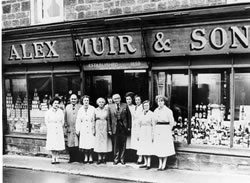 Alexander Muir established his family grocery and wine merchant`s business in 1859. The shop was located at 9 Townhead Street. Alexander came from Paisley to Cumnock and was described as 'Cumnock`s first practical grocer, in the modern acceptance of the term'. He was a keen member of the 12th Ayrshire Rifles and was one of the nine people to sign the petition which led to the formation of Cumnock Burgh. He died in 1886 and was followed by his son James, who died in 1941 - who was succeeded by his son Alexander who died in 1964. It is Alexander who is in the centre of the photograph opposite.
Alexander Muir established his family grocery and wine merchant`s business in 1859. The shop was located at 9 Townhead Street. Alexander came from Paisley to Cumnock and was described as 'Cumnock`s first practical grocer, in the modern acceptance of the term'. He was a keen member of the 12th Ayrshire Rifles and was one of the nine people to sign the petition which led to the formation of Cumnock Burgh. He died in 1886 and was followed by his son James, who died in 1941 - who was succeeded by his son Alexander who died in 1964. It is Alexander who is in the centre of the photograph opposite.
Muir's sold their own blend of whisky labelled Corsegellioch after the hill which stands to the south of Cumnock. The whisky was a blend of Ardbeg, Islay and Cambus malts and was bottled on Muir`s premises. It sold for sixpence per gill.
The business closed in April 1964 after the death of Alexander Muir.
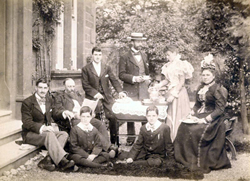 S & A Galbraith`s established their grocery business in Cumnock in 1849. Their first shop was in the Square. In 1890 Samuel Galbraith bought buildings at the corner of Tower Street and Elbow Lane and he converted these into a large grocery shop. In the rear he erected a factory where confectionery and jams were made. Galbraiths was demolished in the late 1960`s to make way for more car parking facilities adjacent to Tower Street. At the time it was owned by Spence Galbraith. Galbraith`s then established a Cash and Carry business in Cairn Road in December 1970 as part of the Mace Group.
S & A Galbraith`s established their grocery business in Cumnock in 1849. Their first shop was in the Square. In 1890 Samuel Galbraith bought buildings at the corner of Tower Street and Elbow Lane and he converted these into a large grocery shop. In the rear he erected a factory where confectionery and jams were made. Galbraiths was demolished in the late 1960`s to make way for more car parking facilities adjacent to Tower Street. At the time it was owned by Spence Galbraith. Galbraith`s then established a Cash and Carry business in Cairn Road in December 1970 as part of the Mace Group.
Samuel Galbraith was elected as a councillor from 1901-1904. Photos shows Samuel and family outside their house in the Holm.
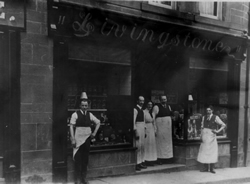 Set up and run by Mrs Janet Livingstone, she was succeeded by her son Robert then James. The first premises were further down Lugar Street - in premises which are now demolished. The next shop was at 15 Lugar Street and Janet Livingstone moved there c1880. The Livingstone family sold the shop in 1967 - but it continued to trade as Livingstone`s until 1982. The shop now houses Crowdstoppers.
Set up and run by Mrs Janet Livingstone, she was succeeded by her son Robert then James. The first premises were further down Lugar Street - in premises which are now demolished. The next shop was at 15 Lugar Street and Janet Livingstone moved there c1880. The Livingstone family sold the shop in 1967 - but it continued to trade as Livingstone`s until 1982. The shop now houses Crowdstoppers.
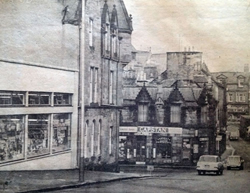 Mario Luni`s Cafe was situated at the Corner of Ayr Road. The building was erected in 1873 on the site of the town toll. The 1873 building originally had two shops on the ground floor and previous occupiers were MacKervail`s, Hugh Lorimer`s clothing shop, R Craig, a millinery run by James Millar, and a confectioners run by Mary Miller. From about 1915 until the building was demolished, it was the premises of Mario Luni and then his son Ernesto - ice cream makers.
Mario Luni`s Cafe was situated at the Corner of Ayr Road. The building was erected in 1873 on the site of the town toll. The 1873 building originally had two shops on the ground floor and previous occupiers were MacKervail`s, Hugh Lorimer`s clothing shop, R Craig, a millinery run by James Millar, and a confectioners run by Mary Miller. From about 1915 until the building was demolished, it was the premises of Mario Luni and then his son Ernesto - ice cream makers.
Banks
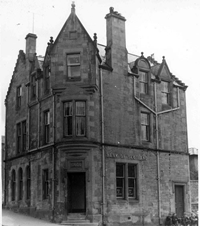 The first branch of the Bank of Scotland in Cumnock was opened on 2nd May 1838 at the home of Matthew McKerrow, cloth merchant. It was a joint agency of Matthew McKerrow and Hamilton Rose, solicitor. Matthew McKerrow retired in 1863 and Hamilton Rose in 1868.
The first branch of the Bank of Scotland in Cumnock was opened on 2nd May 1838 at the home of Matthew McKerrow, cloth merchant. It was a joint agency of Matthew McKerrow and Hamilton Rose, solicitor. Matthew McKerrow retired in 1863 and Hamilton Rose in 1868.
In 1870 the bank erected premises at the corner of Ayr Road and Glaisnock Street. The architects were J D Peddie and C G H Kinnear of Edinburgh. This building was used by the bank until new premises were built in Townhead Street - still currently used by the Halifax Bank of Scotland. The old bank building has since been used by a printer and then a solicitor.

The present Clydesdale Bank building at 30 The Square dates from around 1881 and succeeded premises at 18-20 The Square, known as Clydesdale House. Clydesdale House itself was built c1847.
Some title deeds for the Clydesdale House site date to 12th March 1807 and were granted by William Howat to James Baird. James Baird sold the property to the Trustees of the Ayrshire Savings Bank in 1834. The Ayrshire Savings Bank retained the property until 1847 when they transferred it to the Trustees of the Western Bank of Scotland who then proceeded to build what is now known as Clydesdale House.
The Trustees for the Western Bank of Scotland sold the property to the Clydesdale Banking Co in 1857, and they in turn sold the property to David Brown Cree, pawnbroker by public roup (auction) in 1883, presumably after moving to the newly built Bank at No 30 which survives to the present day.
 The branch opened in Cumnock around 1920 - the first agent was R D Hunter a post which he held until his death in 1941. He was succeeded by his son who became Town Clerk of Cumnock - and ran the bank jointly with Hugh Morton Reyburn and later with J B Watson.
The branch opened in Cumnock around 1920 - the first agent was R D Hunter a post which he held until his death in 1941. He was succeeded by his son who became Town Clerk of Cumnock - and ran the bank jointly with Hugh Morton Reyburn and later with J B Watson.
It is said that Mr Reyburn closed the bank in the middle of the day when the Queen and Prince Philip visited Cumnock - this allowed staff to see the motorcade go by
The Bank stood at No. 2 the Square and the site was occupied prior to 1875 by a grocery business run by the Hunter family. After 1875 William Hunter returned to Cumnock from Glasgow University and started trading as an ironmonger, cycle agent, gramophone dealer and optician. He was succeeded by Hugh D. Hunter.
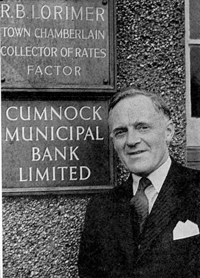 Cumnock`s Municipal Bank was incorporated as a Private Limited Company on 2nd April 1928. The original shareholders were Allan McCall (fruit merchant) Alexander Borland (ironmonger) John Wilson (retired engineer) James Neil (retired electrical engine keeper) George Bridges (teacher) George McTurk (miner`s agent and J.P.) and Emrys Hughes (journalist). All of the shareholders were members of Cumnock Town Council at the time.
Cumnock`s Municipal Bank was incorporated as a Private Limited Company on 2nd April 1928. The original shareholders were Allan McCall (fruit merchant) Alexander Borland (ironmonger) John Wilson (retired engineer) James Neil (retired electrical engine keeper) George Bridges (teacher) George McTurk (miner`s agent and J.P.) and Emrys Hughes (journalist). All of the shareholders were members of Cumnock Town Council at the time.
The shareholders did not receive a dividend and all the directors (Borland, Bridges, Hughes and Neil) were unpaid. All the profits from the Bank were passed to the Town Council.
The first manager of the Bank was John Allan, Burgh Treasurer, and business was conducted from his office in Ayr Road. In 1931, when John Allan took up a post with Ayr County Council, James Gibb was appointed as manager. After the sudden death of James Gibb his brother Charles was appointed his successor and the business was carried on from premises in Lugar Street. In 1944 to widen the scope for deposits another branch was opened in the Town Chamberlain`s Office with R. B. Lorimer in charge. Charles Gibb resigned in 1946 and R. B. Lorimer took full charge of the Bank.
The Bank amply fulfilled the expectation of the original sponsors who believed that local ratepayers would welcome a simple and safe method of local investment.
In 1937 the deposits amounted to £13,600 and in 1946 they amounted to £24,200 and by 1960 they had increased to £98,900 all of which was on loan to Cumnock Town Council. The moderate rate of interest paid by the Town Council ensured considerable benefits to ratepayers. In June 1960 there were 200 accounts which equalled one account for every eight households in Cumnock.
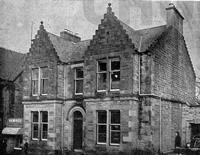 The first reference to a branch of the Royal Bank of Scotland in Cumnock is the purchase of a fire-proof safe in 1856. This branch was rented for the next 10 years and in 1866, after the granting of a Feu Charter, work began on building the present building in Glaisnock Street.
The first reference to a branch of the Royal Bank of Scotland in Cumnock is the purchase of a fire-proof safe in 1856. This branch was rented for the next 10 years and in 1866, after the granting of a Feu Charter, work began on building the present building in Glaisnock Street.
Prominent merchants and tradesmen listed in an early "charge book" are Murdoch (mason) McLeod (joiner) Paterson (draper) Ballantine (stationer) McGeachan ( ironmonger) McLatchie (joiner) Gibb (plumber) Willock (painter) McCririck (carrier) and Merry (blacksmith).
 Cumnock Chronicle October 25th 1968
Cumnock Chronicle October 25th 1968
Glasgow Savings Bank Opening
After performing the official opening ceremony. Provost Finn welcomed the bank to Cumnock, stating that this was only the third new bank in the town in 111 years, and it had been 40 years since the last addition to Cumnock’s banking facilities. It was, surely, a strong indication of the growing importance of the town.
The Trustees Savings Bank Association had a long and honourable record of encouraging thrift amongst the ordinary men and women of Britain, and the Scots had played a notable part in this record. Indeed it was a Scottish minister, the Rev. Henry Duncan, who was credited with founding the movement at Ruthwell in Dumfriesshire. His bank prospered, and soon other places adopted the idea and formed their own banks. There was one essential feature of this movement which deserved the fullest publicity; since the foundation on 1810 these Trustee Savings Banks had been, and continued to be, administered by trustees and managers who gave their time and work without receiving any payment whatsoever – a truly wonderful example of community service.
The Glasgow bank opened in 1836 and, by vigorous and careful management, it had grown over the years until now it was considered to be one of the foremost Savings Banks in the U.K. Today the Town Council applauded the bank’s decision to open a branch in Cumnock. In 1959 the council had signed an overspill agreement with the City of Glasgow. They had waited patiently, and he wondered if this was the first result of that agreement? To the industrial chiefs of Glasgow he said “ If you want further success, be wise and follow the example of your Savings Bank. Come to Cumnock”. Provost Finn concluded – “In conclusion may I express to you, Sir Thomas, and all the officials of your bank, my hope that this new venture will be crowned with every success – Let Glasgow flourish – In Cumnock”
In replying to the Provost and thanking him for his kind welcome, Sir Thomas Dunlop said the trustees had had Cumnock very much in mind for several years, and the late Mr. Robert Welsh, Town Clerk R. D. Hunter’s uncle, had made certain they did not forget Cumnock by mentioning its merits when he was chairman of the Ayr and Prestwick Advisory Committee. With the influx of new industries and the energetic efforts of the Town Council to improve the town’s prosperity, it was felt that the bank could pay its way in Cumnock. With some help from neighbouring towns and villages their funds, in time, could exceed £1 million.
The speaker referred to Catrine’s “Penny Bank” run under the auspices of Messrs J. Finlay and Company and to a similar bank which was started at Muirkirk by the office bearers of Kames Church. He contended that no modern town was complete without a trustee savings bank. Sir Thomas took the opportunity of introducing the Cumnock branch manager, Mr J. McVie, who formerly served with the bank at Prestwick, Troon and Irvine. He concluded by thanking the contractors and all who had been responsible for the alteration and preparation work at the new premises.
The trustees entertained the councillors and other guests to lunch, and after this delightful meal Sir Thomas DUNLOP praised the council for their energetic drive to put Cumnock on the industrial map – efforts which has already been crowned with a great deal of success. It was obviously an enterprising local authority which won a Saltire Award and Civic Trust Commendation for their new houses. He had a personal word of praise for Provost FINN, a councillor of 18 years whose family connection with Cumnock dated back about 150 years. He had played a big part in the successful progress of Cumnock and he was helping to build a self-reliant community. He hoped the bank would be able to assist in this task. Sir Thomas proposed the toast to “Cumnock” and reply was made by Provost T. Finn, who thanked the speaker for his fine tribute. It was pleasant to hear themselves praised with such eloquence. About 20 years ago they had been perturbed to note that former industries connected with the town had nearly all vanished, and only mining and agriculture remained. They set out to attract new industry but at first no one listened to them.
The struggle was long and arduous, but gradually they wore down the resistance and made those in authority aware of the need; made them realise that not only was there a need but that the right type of people were being attracted to Cumnock. Today they felt they had turned the corner; the town was beginning to boom and its future was assured. Around them at this function were the representatives of the industries that had come into the town and that had expanded in the town. They could tell much better than the Provost what conditions they had found. The town had a fairly happy community with good relationships between the people and the industrialists. The council did all in its power to help the incoming firms. Some problems could not be solved immediately but he believed the firms all realised this and appreciated what was being done on their behalf.
In welcoming the bank; the Provost said it was not the first savings bank in the town. In 1831- five years before the formation of the Glasgow Bank – Cumnock had a savings bank with over 200 depositors. What happened to it history does not tell. Presumably, he said, it merged with one of the other banks which were formed a few years later. But history did record that it was a most flourishing concern and that this was due to the work done by a Mr CAMPBELL. He felt sure that the fact that, today, the bank General Manager, Mr CampbellL, was with them was surely a happy augury for the success of this new branch.
Guest listIn addition to Sir Thomas Dunlop and Provost Tom Finn, the guests at the opening ceremony in the bank at Townhead Street included – Police Judge J. K. H. McTurk, Bailie J. King, Bailie D. B. Lorimer, Treasurer T. Guthrie, R. B. Lorimer, Town Chamberlain, J. D. CampbellL, General Manager Savings Bank of Glasgow, J. Cameron and R. Y. Henderson, Trustees of the Savings Bank of Glasgow, A . M. N, Retired General Manager Savings Bank of Glasgow, Rev. Dr. J. D. M’Clymont, Cumnock Old Church, W. B .M McConville, Assistant General Manager of the Savings Bank of Glasgow. W. J. Putman, Development Officer Savings Bank of Glasgow, J. Y. McVie, Branch Manager, Savings Bank of Glasgow at Cumnock, Jas. R. Wilson, Agent Savings Bank of Glasgow (Sanquhar), I. M. Rodney, Master of Works Savings Bank of Glasgow, R. Forret, Burgh Surveyor, J. G. Taylor, E. F. Armitage and John Nicol of Finlay’s (Catrine), J. H. Kennedy, Bank of Scotland, W. W. Rodger, Royal Bank of Scotland, H. G. R. Kerr, National Commercial Bank of Scotland, A. G. MacArthur, Clydesdale Bank, R. Lauchlin, Rector Cumnock Academy. P. K. Drummond, Brakenridge and Graham, J. R. Shaw, National Savings Committee, E. F. McDermid, Registrar, Councillor W. McDonald, J. S. Watson, Cumnock Knitwear, R. Aird, Monsanto, C. Wilkinson, Gray’s Tufted, D. S. A. Gibb, N.C.B., J. R. Outram, Foster’s, R. M. McWhirter, Kyle Knitwear, F. Colman, Holybush Knitwear, T. Bradford, Postmaster, D. M. Ballantine, Editor Cumnock Chronicle, W. T. Paton., Main Contractor, Ayr, Mrs I. J. Connell, D. Connell and Co., Miss D. Turner of the Department of Employment and Productivity, Mrs M. D. Wilson, Dumfries Arms Hotel, Rev. A. Murphy, St. John’s Presbytery, Jas. T. Cree, Headmaster Greenmill Primary School, Geo. McEwan, Scottish Gas Board, W. A. Stewart, Painting Contractor for the new office, J. K. Thomson, Townhead Garage, and D. McGarva, Cowan and Panton Ltd






